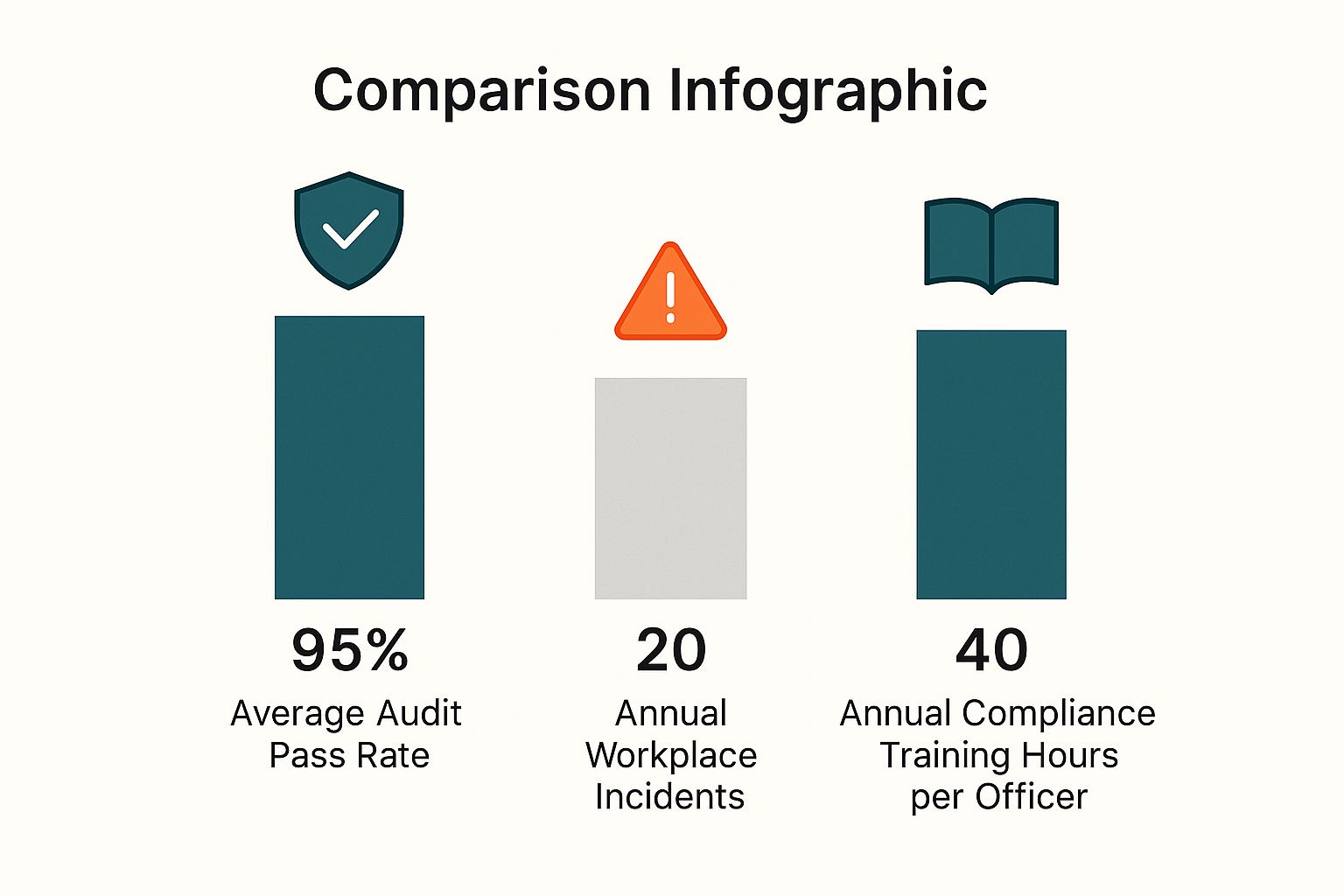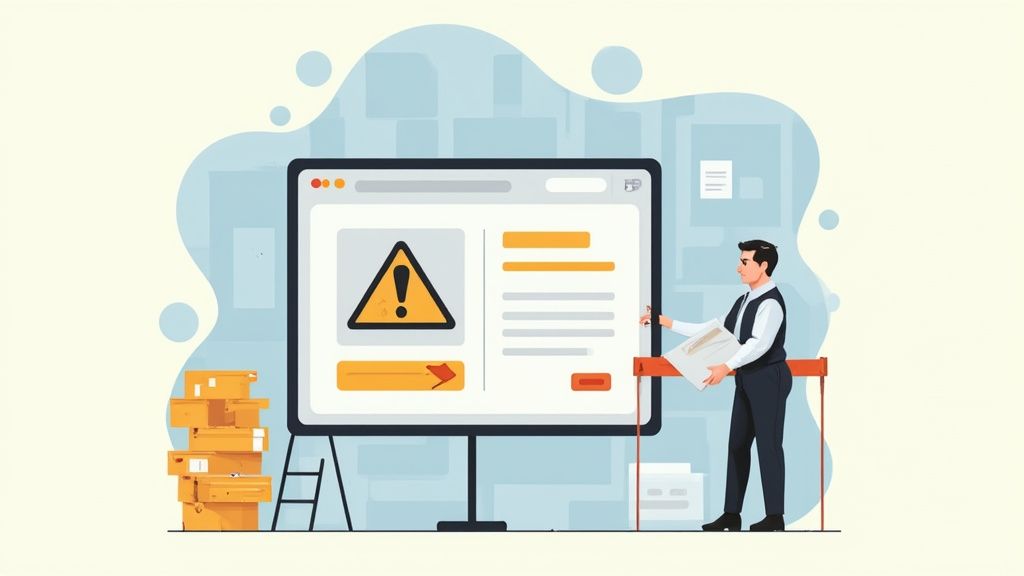Think of a safety and compliance officer as the guardian of a workplace. Their job is to make sure the company is following all the necessary health and safety rules, not just to tick a box, but to prevent accidents and protect people from harm.
They are the eyes and ears on the ground, spotting risks before they turn into real problems. This role is absolutely critical in high-risk industries like construction and manufacturing, where the stakes are highest.
What a Safety and Compliance Officer Actually Does
Let's cut through the corporate jargon. The real mission here is simple: protect people and the business by making sure the rules are followed. They're the expert who connects complex regulations to what’s actually happening on-site.
This isn’t a desk job about paperwork. It's about being present on the factory floor or construction site, watching how things are done, and talking to the crew to understand the real-world challenges they face. Their work is a constant loop of observing, assessing, and taking action.
The Nitty-Gritty: Day-to-Day Responsibilities
The daily grind for a safety and compliance officer is all about proactive prevention. You'll often find them moving between the office and the worksite, juggling several key functions at once.
To give you a clearer picture, here’s a breakdown of what a typical day might involve.
Daily Responsibilities of a Safety and Compliance Officer
| Task | What It Looks Like in Practice | Why It Matters |
|---|---|---|
| Site Inspections | Regularly walking the floor to spot things like unguarded machinery, dodgy electrical setups, or blocked fire exits. | Catches immediate physical dangers before they can cause an injury. It’s about proactive, hands-on prevention. |
| Risk Assessments | Systematically looking at a specific job or piece of equipment and figuring out the safest way to get the work done. | Moves safety from a vague idea to a concrete plan, making sure controls are in place for specific, known hazards. |
| Incident Management | Investigating what went wrong when an accident or near-miss happens, finding the root cause, and putting steps in place to stop it from happening again. | Turns every incident, big or small, into a learning opportunity to make the workplace safer for everyone in the future. |
These tasks form the backbone of the role, making sure that safety isn't just a policy document but a lived reality for every single person on site.
In Australia, this role goes beyond just physical safety checks. It's also about building internal systems to standardise how things are done and cut down on non-compliance. When a breach does occur, these officers lead the investigation and make sure management knows exactly what happened, so they can act fast. You can find more detail on the specifics of the compliance officer role in Australia and its legal duties.
Staying Ahead of the Rules
One of the toughest parts of the job is keeping up with constantly changing legislation. Government bodies are always updating health and safety standards. The safety and compliance officer has to not only understand these updates but also figure out how to translate them into practical policies that work on the ground. It’s a role that demands continuous learning.
The real job is turning complex legal requirements into simple, actionable steps that people can actually follow on a busy worksite. It's about making safety practical, not just theoretical.
Ultimately, they are the bridge between the regulators and the company's day-to-day operations. This makes sure the business doesn’t just avoid fines and legal dramas, but builds a place where everyone feels safe enough to do their best work.
How a Good Compliance Officer Adds Value

It’s tempting to see a safety and compliance officer as just another operational cost, but a skilled one is a serious asset. Their real value isn't in ticking boxes; it's in prevention. They stop problems long before they spiral into shutdowns, legal battles, or a damaged company reputation.
They’re the ones keeping the business ahead of the curve on regulatory changes.
By knowing the rules inside and out, they shield the company from incredibly expensive mistakes. Think about a construction project that sidesteps major delays because an officer flagged a compliance issue early on. Or a manufacturing line that avoids a product recall by sticking to rigid safety protocols. This has a massive, direct impact on the bottom line.
Their work also builds a stable, productive environment where your team feels genuinely looked after. When people know someone has their back from a safety perspective, they can focus on their jobs with more confidence. This isn't just a "nice-to-have," it reduces staff turnover and improves overall output.
From Cost Centre to Profit Protector
It’s a common mistake to view compliance as purely an expense. A good officer actively protects company profits by preventing the very situations that drain a business of its resources.
This is especially true here in Australia, where both regulatory demands and enforcement actions are getting tougher. In fact, regulatory actions shot up by 30% during the 2022-2023 financial year, a loud and clear signal of heightened scrutiny across most sectors. This trend puts even more pressure on the safety and compliance officer to get every single detail right.
A proactive officer doesn’t just put out fires; they build systems to stop them from starting in the first place. This forward-thinking approach is what separates a truly great compliance function from an average one.
A great safety and compliance officer saves the company far more money in avoided fines and shutdowns than their salary ever costs. They are an investment in operational continuity and financial health.
By managing everything from permits to daily safety checks, they make sure the business can operate without costly interruptions. This is absolutely critical for achieving and maintaining approvals like a global compliance certification, which can open up new markets and bigger contracts.
Ultimately, they make sure the business isn’t just compliant today, but is ready for whatever regulations come tomorrow.
The Pros and Cons of the Job
Just like any career, being a safety and compliance officer has its good days and its tough ones. It’s a role that really calls for a certain kind of resilience and rewards a practical, hands-on approach. So, before you jump in, it’s worth taking a good look at both sides of the coin.
On the one hand, the job brings a huge amount of personal and professional satisfaction. You get to make a real, tangible difference in people's lives. When you stop an incident from happening, you’re not just saving the company a fine; you’re making sure someone gets to go home to their family, safe and sound.
This infographic gives you a snapshot of some of the key metrics a safety and compliance officer juggles throughout the year.

You can see it’s a constant balancing act, proactive work like training sessions and achieving high audit pass rates are measured against the ultimate goal of driving down workplace incidents.
Pros vs Cons of a Career as a Safety and Compliance Officer
To really understand what you're signing up for, it helps to see the rewards and challenges laid out side-by-side. It’s not just about knowing the rules; it’s about navigating the very human, and often messy, reality of implementing them.
| The Pros (The Rewards) | The Cons (The Challenges) |
|---|---|
| Making a tangible impact. You directly contribute to a safer workplace and can see the positive results of your efforts. | The weight of responsibility. The pressure can be intense, especially when an incident occurs. You are the focal point. |
| High demand and job security. Skilled safety professionals are always needed, offering a stable and reliable career path. | Constant battle for buy-in. Convincing management to invest and workers to change habits can be an uphill struggle. |
| Intellectual stimulation. The role involves continuous problem-solving, navigating complex regulations, and applying them practically. | The need for lifelong learning. Regulations and standards are always changing, requiring constant professional development. |
| Authority and respect. You become a critical, respected expert on the operational team, guiding key decisions. | Requires a thick skin. You often have to be the enforcer, which isn’t always a popular position to be in. |
Ultimately, it’s a role for people who are driven by purpose. The challenges are real, but for the right person, the rewards of keeping people safe far outweigh the difficulties.
The Rewards of the Role
The intellectual challenge is a massive drawcard for many. You’re constantly solving puzzles, deciphering complex regulations and figuring out how to apply them to messy, real-world situations. If you enjoy problem-solving and are always keen to learn something new, this part of the job is incredibly engaging.
There’s also a consistently high demand for skilled professionals in this field.
- Job Security: Good safety and compliance officers are always needed, particularly in high-risk industries like manufacturing, resources, and construction. This makes for a very stable career path.
- Tangible Impact: Your work directly results in a safer workplace. You can literally point to reduced incident rates and better processes and know you made that happen.
- Authority and Respect: As the go-to expert on all things safety, you become a critical and respected voice on the team, helping to steer the ship.
The Challenges to Consider
But let's be honest, the role isn't all smooth sailing. The pressure can be immense. When something goes wrong, all eyes turn to you, and the responsibility for preventing incidents in the first place can weigh heavily. It definitely requires a thick skin and the ability to keep a cool head when things get heated.
Another major hurdle is getting buy-in from everyone else. You often have to convince management to spend money on safety measures or persuade workers to break habits they’ve had for years. This takes serious communication and negotiation skills, as you're constantly making the case for why safety has to come first.
The toughest part of the job isn't knowing the regulations; it's getting people to actually follow them, day in and day out. You have to be a teacher, a negotiator, and an enforcer, often all in the same conversation.
Finally, the regulatory landscape never sits still. Laws and standards are constantly being updated, which means you have to commit to lifelong learning just to keep up. It can be draining, and falling behind simply isn't an option.
Using Software to Tip the Scales
This is where modern tools can make a world of difference. Platforms like Safety Space help manage some of the biggest challenges. By automating routine tasks like filling out forms and generating reports, it frees up your time to focus on the human side of the job, things like training, coaching, and being present on-site.
A centralised platform also makes it much easier to track compliance and show the value of your work to management with clear, undeniable data. This helps you build a stronger case for new safety initiatives and, ultimately, have a bigger impact where it matters most.
How Software Gives Compliance Officers More Impact
Let's be honest, even the most dedicated safety and compliance officer gets bogged down by manual processes. We've all seen it: stacks of paper, scattered spreadsheets, and endless data entry that steal precious time. That's time that should be spent on the factory floor or construction site, where it actually counts.
This is where the right software completely changes the game.
Instead of spending hours transcribing handwritten inspection notes, an officer can use a tool like Safety Space to complete digital forms on a tablet right there on the spot. The data is captured instantly, reports are generated automatically, and corrective actions can be assigned before they even leave the area. This shift alone can free up a huge chunk of their week.
This newfound time is what allows them to go from being reactive administrators to proactive safety leaders. They can finally focus on the high-impact activities that the mountain of paperwork always seems to push aside.

From Paperwork to Practical Action
The real magic of dedicated software is how it turns scattered bits of information into organised, actionable intelligence. It creates a single source of truth for all safety and compliance data, making it so much easier to see the bigger picture and connect the dots between seemingly random events.
Think about how this works in the real world:
- Centralised Incident Reporting: When a near-miss is reported on a digital platform, it doesn't just sit in a folder waiting for someone to find it. It's logged, categorised, and added to a central database immediately. Nothing gets lost.
- Spotting Dangerous Trends: Over time, the software starts to analyse this data and reveal patterns you’d never spot otherwise. Maybe it shows that a specific type of incident keeps happening on a particular shift, or with a certain piece of machinery.
- Getting Ahead of Accidents: Armed with this data, a safety and compliance officer can dig into the root cause and put targeted solutions in place before a minor issue turns into a major accident.
A digital system transforms the role from record-keeping to risk forecasting. Instead of just documenting what went wrong, an officer can use data to predict where the next problem is likely to occur.
This data-driven approach is far more powerful than relying on memory or gut feelings. It provides hard evidence to back up safety recommendations, making it much easier to get buy-in from management for needed changes.
Making Compliance Audits Smoother
Anyone who has prepared for an audit with a manual system knows the nightmare. It’s a frantic scramble, hunting down documents, chasing signatures, and just hoping nothing critical is missing. A platform like Safety Space organises everything automatically as you go.
Imagine an auditor asks for all training records for your forklift operators from the last 12 months. With a digital system, the compliance officer can pull a comprehensive report in minutes, complete with dates, signatures, and certification details. This doesn't just save an immense amount of time and stress; it shows a robust, well-managed compliance program.
The goal here isn't to replace the officer. It’s to amplify their skills. By taking over the repetitive, administrative grind, software frees them up to focus on the human side of safety, coaching workers, refining procedures, and building a stronger workplace. It helps them spend less time managing paper and more time preventing harm.
Navigating a Complex and Changing Regulatory World
For a safety and compliance officer, the only constant is change. Regulations aren't static documents gathering dust on a shelf; they’re living things, constantly being updated, amended, or completely overhauled. Trying to keep up with this manually is like trying to catch mist in your hands. It’s an overwhelming and frankly impossible task.
This pressure is cranked up to ten in high-risk sectors like construction or manufacturing, where the rules get incredibly specific and complex. The sheer volume of updates from different regulatory bodies quickly becomes noise, making it difficult to pinpoint what actually applies to your operations. It’s a huge source of stress for anyone in the role.
Turning Overwhelm into a Manageable Process
This is where good technology becomes a non-negotiable part of the toolkit. Modern platforms act as a filter, cutting through all that noise to deliver only the relevant updates directly to you. Instead of burning hours each week trawling through government websites and industry newsletters, an officer can get targeted alerts about changes that actually impact their workplace.
For example, tools inside software like Safety Space can scan for new legislation and check it against the company’s existing compliance framework. This turns the monumental job of tracking regulatory shifts into a systematic, manageable process. It allows an officer to shift from being a reactive rule-checker to a proactive advisor who can get the business ready for what’s coming down the pipeline.
This shift isn't just a nice-to-have. Recent insights show that 85% of Australian compliance professionals report a spike in regulatory complexity, highlighting the growing mountain of rules they have to manage. Despite this, 73% believe AI can genuinely help them do their jobs more efficiently, showing a quiet confidence in technology's role. You can discover other critical stats for compliance officers in 2025 and explore these trends further.
From Reactive to Proactive Hazard Management
When a safety and compliance officer has the right tools, they get their time back, time they can now spend on strategic work. They can properly analyse how a new regulation will affect procedures on site and plan for a smooth transition, instead of scrambling to play catch-up after a new rule is already in effect. This proactive approach is vital for sidestepping non-compliance penalties.
It also helps in spotting potential hazards before they become normalised parts of the workday. A system that flags a regulatory update can trigger an immediate review of current risk assessments. A new rule on chemical storage, for example, might prompt a review of how materials are handled on-site, potentially preventing a serious incident down the track. This is far more effective than just documenting accidents after they happen, which is a key part of understanding what a near miss is and why it matters.
By using technology to stay on top of regulatory monitoring, officers can redirect their expertise toward practical implementation and risk mitigation. The goal is to spend less time reading the rulebook and more time making those rules work in the real world.
Practical Takeaways for Safety and Compliance Officers

The role of a safety and compliance officer is far more strategic than just enforcing rules. At its core, it's about actively protecting people and the company’s bottom line by stopping costly incidents before they can ever happen.
But let's be honest, getting bogged down in administrative tasks is the single biggest barrier to making a real, lasting impact.
Moving Beyond Administration
The most effective officers I've seen don't let paperwork run their day. They use technology to handle the repetitive, time-consuming parts of the job, like generating reports and chasing up data entry. This frees them up to focus on high-impact work.
What does that look like in practice? It means more time on the floor, coaching teams, and identifying risks with your own eyes, not just from behind a desk.
The real value of a safety and compliance officer is unlocked when they can move from being a record-keeper to a proactive safety leader. Technology is what makes this shift possible.
Tools like Safety Space help turn compliance from a mountain of paperwork into a clear, manageable system. When you can easily track data, spot trends, and show real progress, you can build a much stronger case for safety investments with management.
For anyone aspiring to this role, focus on mastering two things: deep regulatory knowledge and the practical skills needed to manage a modern safety management system.
And if you're already in the job? It's time to take a hard look at your current toolset. By adopting technology that simplifies compliance, you can stop managing paperwork and start leading safety initiatives that truly protect your workplace.
Got Questions? We've Got Answers
Thinking about a career as a safety and compliance officer? It's a role with a lot of moving parts. Here are a few of the most common questions we hear from people looking to get into the field.
What Qualifications Do I Need to Get Started?
There isn't one single path, which is great because people come into this field from all sorts of backgrounds. That said, most employers will look for a solid foundation. This often means a degree in a relevant area like occupational health and safety or environmental science.
But the theory only gets you so far. Practical, hands-on experience is gold, especially in high-risk industries like construction or manufacturing where you really need to understand the environment. To top it off, professional certifications like the Certified Safety Professional (CSP) show you're serious about your craft and are highly respected.
How Does Software Actually Help with Risk Assessments?
This is where things get interesting. Good software takes risk assessments from a scattered, inconsistent chore to a streamlined, powerful process. Instead of one person using a Word doc and another using a random spreadsheet, everyone works from the same digital template. Nothing gets missed.
Even better, a platform like Safety Space creates a single source of truth, a live database of every risk, who's responsible for fixing it, and when it's due. For a safety and compliance officer, this is a game-changer. You can spot trends, track progress, and pull together data-backed reports for leadership in minutes, not days.
What’s the Toughest Part of the Job?
Hands down, one of the biggest hurdles is getting genuine buy-in from top to bottom. A safety officer can know the rulebook inside and out, but if front-line workers don't follow procedures or executives don't champion the cause, it's an uphill battle.
This is where communication skills are make-or-break. The best officers don't just enforce rules; they explain the 'why' behind them. They frame safety not as a box-ticking exercise to avoid fines, but as a core part of keeping everyone safe, productive, and making sure the business runs without a hitch.
Ready to see how technology can simplify your processes? Safety Space offers an all-in-one platform to manage inspections, incidents, and compliance with ease. Book a free demo and get an H&S consultation today.
Ready to Transform Your Safety Management?
Discover how Safety Space can help you build a safer, more compliant workplace with our comprehensive safety management platform.
Book a Free DemoRelated Topics
Safety Space Features
Explore all the AI-powered features that make Safety Space the complete workplace safety solution.
Articles & Resources
Explore our complete collection of workplace safety articles, tools, and resources.
